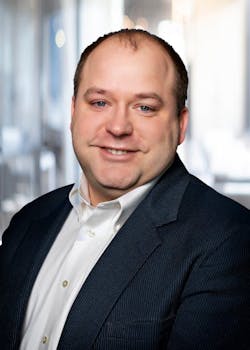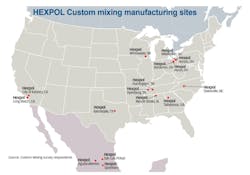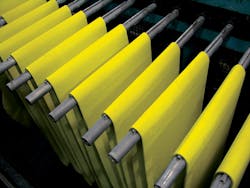Come for the Digitized Maintenance, Stay for Better Leadership
In 2018, one of Hexpol Compounding America's (HCA) plants reported thousands of minutes of downtime per month without any clear data as to where the issue lay: No single asset failing, no group of aging machines lacking timely maintenance, no poor equipment utilization.
Lacking any sort of root cause for the downtime, HCA installed a computerized maintenance management system (CMMS) called eMaint, developed by Fluke Reliability, to track data and find the answer. Following installation in 2019, HCA installed eMaint at 13 additional sites so every plant could operate on the same standards.
The intention was uniformity, not to lay the groundwork for a new, company-wide total preventative maintenance (TPM) initiative that would require HCA to embrace significant leadership challenges. That’s precisely what the company got, however, when John Sedgwick, director of engineering and maintenance at HCA, took the reins in 2020.
Corporate Strategy on the Shop Floor
HCA’s corporate strategy plan includes continuous improvement and lean management goals. Sedgwick’s TPM initiative, that relies in part on leveraging the CMMS, is part of a larger reactive maintenance (RM) plan that ties directly into those goals and justifies investment.
“The struggle I know we had in the past [is that] maintenance is not a focus at the executive level … and so maintenance usually just does their day-to-day, keep the equipment running and that’s it. If we want to strive to improve, we need buy-in from the top. How do we get [that]? … We build off their corporate strategy on their X-matrix and funnel it down into our department,” Sedgwick says.
For example, the strategic plan targets inventory reduction. A CMMS tracks parts inventories and repairs to determine how shelf-life relates to replacement-part needs.
“O-rings don’t last forever. If you sit on a part for 10 years, if it has rubber seals in it, it’s probably bad. We probably shouldn’t be holding on to that because it’s a cost. If we’re relying on that part to work in 10 years and it fails right away, it did us no good to even hold that part. So, should we try to see what’s the lead time to source those products potentially, make sure that’s a very short lead time and then buy it when we need it, versus sitting it on the shelf?” Sedgwick says.
If they sit too long, the bearings in large motors flatten because of the weight. Something as simple as rotating a shaft a quarter turn once a month prevents those motors from becoming write-offs and incurring replacement costs. The CMMS determines the best PM schedules to avoid the motors from failing.
Risk management, another strategic priority at HCA, justifies the establishment of asset criticality analysis programs that require preventative maintenance optimization. A CMMS organizes preventative maintenance programs by recording asset data, work orders and maintenance tasks.
Hexpol Compounding Americas runs 13 sites in the United States and three in Mexico.
Getting Accurate Data
Prior to installation of the CMMS, each of HCA’s plants managed downtime on their own, on the operational side, says Sedgwick. Downtime was designated as “caused by maintenance process issues” or “raw materials not showing up,” to cite two examples. The reports didn’t provide the clarity HCA needed to validate what caused the downtime.
“When you give it to one person to dictate where all the downtime’s coming from, sometimes the data can be biased. We prefer to be able to, if anything, compare what the CMMS is saying versus what production’s reporting to see if they’re at least within the same magnitude,” says Sedgwick.
Capex for software was minimal, Sedgwick says, mostly a licensing fee for each plant using the CMMS. Cloud-based data storage necessitated no additional on-prem IT infrastructure. The appreciable costs came on the labor side, with two time employees spending a third of their time onboarding the 14 sites, validating each plant’s data for upload to the CMMS.
It took around a year to get the original 14 sites online and six months to onboard two additional plants acquired in 2020. Now, HCA had accurate data on downtime and proactive versus corrective work order ratios, but Sedgwick eventually realized he still wasn’t getting the reliability data he wanted.
For instance, proactive versus corrective work ratios effectively punished plants that did an excellent job fixing machine problems. For a problem site, the metric worked well. A gold standard plant would have to fabricate work orders to get the ratio back in their favor.
If production went down on one line because an asset failed, but another line had capacity to pick up the volume such that no orders or shipments were lost, the plant might not consider this downtime and record the data. At an operational level the perspective might make sense, but not at the maintenance level.
Sedgwick and his team therefore rethought the metrics they tracked with the CMMS and shifted to KPIs such as mean time to repair and mean time between failures. Instead of measuring for downtime at the plant level, HCA monitored reliability at the asset level.
Installing the software at every site meant Sedgwick could use real data to measure the effectiveness of new maintenance standards that supported his larger RM plan. Now the challenge was figuring out how to get site maintenance leaders with disparate personalities from 16 different plants to accept the new standards and work toward the same goal.
Compounded rubber conveyed down a cooling line.
Building Teams and Trust
Two years ago, Sedgwick began holding monthly calls with his site maintenance team leaders to share knowledge, discuss best practices and offer solutions for issues their colleagues struggled with. Not everyone was happy with the arrangement or understood why they were suddenly discussing things such as risk management.
It took two years of site visits and giving his maintenance leads a chance to get to know him personally before the new communication plan smoothed out. Now, Sedgwick routinely offers up new strategic plans for review and asks his team leaders to “tear them apart.”
“There’s one maintenance manager that probably had the most pushback day one. He’s the most engaged now, and I think a lot of that has to do with him understanding how this all ties together. We’re not just doing something to check a box. We’re trying to make [strategic plans] fit what we’re trying to do.
“We’re not implementing everything the reliability centered maintenance textbook tells you to. We’re only doing the things that we know we can control and that are actually going to give us the benefits we need,” Sedgwick says. And the CMMS provides real truth on whether the new policies deliver results or not.
In October 2023, at the request of some of his site leaders, Sedgwick for the first time got the entire maintenance team together for an annual meeting. This time it was Sedgwick who felt the hesitation. How could he pull all 16 leaders from their sites when they were usually tied up with the day-to-day? How could he justify the expense? And if people were afraid to talk on a Teams call with the camera off, would they want to communicate as a group, in person?
“We presented what our three-year strategy looks like, allowed them to talk about it, tried to identify all the areas they struggle in like time management and prioritization, being a leader in your department at the site level, stuff they never had that exposure to,” Sedgwick says. “We made it more about trying to develop them, not trying to get them to talk about things they didn’t want to talk about.
“I had the same feeling everybody was going to sit there and not say a word… and we were not going to get the benefit out of it. It was the opposite. Everybody got to know each other and everybody loosened up a lot. Just trying to get that social aspect together really helps get them to open up, talk through things, work as a group.”
This year, he added quarterly one-on-ones with site leaders to serve people that still might not feel comfortable speaking out in meetings, make sure larger goals meet the specific needs of individual plants and that everyone has the resources they need.
“A good example is trying to find maintenance technicians. If we have three openings at a site and not seeming like we’re getting any resumes for interviews I can try to go to HR and figure out what’s going on. What do we need to do to get this done?” Sedgwick says.
“I don’t think that’s ever happened before, where [the site leads] actually had people ask them if they need help with something. It’s always been ‘Here, do this, do this.’ So that’s been something we rolled out this year to try to get more people to open up, to feel like it’s a team effort.”
The Road to Continuing Improvement
Thanks to the years of cooperative efforts to improve maintenance standards and get the supporting infrastructures in place, Sedgwick in 2023 rolled his TPM plan out to three plants in the U.S. and one plant in Mexico.
The lines that switched to HCA’s new TPM program showed after one year an average 5.2% increase in OEE. The best of the lines enjoyed an 8.6% improvement. Three additional sites will move onto the TPM program in 2024.
“I would say the reason we’re improving is because [the data] is visible now to the sites. They weren’t measuring it like this in the past. It helped them see what their results were, know where they’re supposed to be going and target those things,” Sedgwick says.
The reason is also because site maintenance leadership together figured out the best standards and policies to achieve those results. The CMMS just confirms the changes deliver results. It’s thanks to cross-site cooperation, replicating those results at all 16 sites, that achieving his final reactive maintenance plan lies within reach.
About the Author
Dennis Scimeca
Dennis Scimeca is a veteran technology journalist with particular experience in vision system technology, machine learning/artificial intelligence, and augmented/mixed/virtual reality (XR), with bylines in consumer, developer, and B2B outlets.
At IndustryWeek, he covers the competitive advantages gained by manufacturers that deploy proven technologies. If you would like to share your story with IndustryWeek, please contact Dennis at [email protected].




